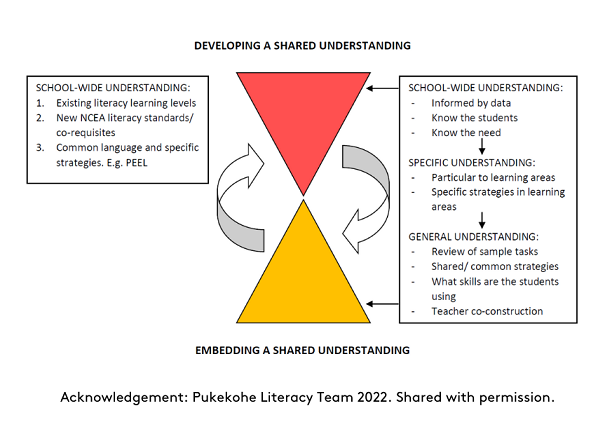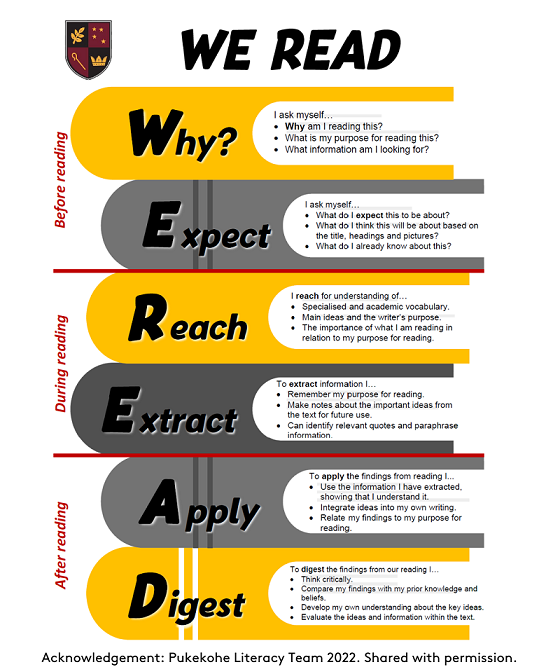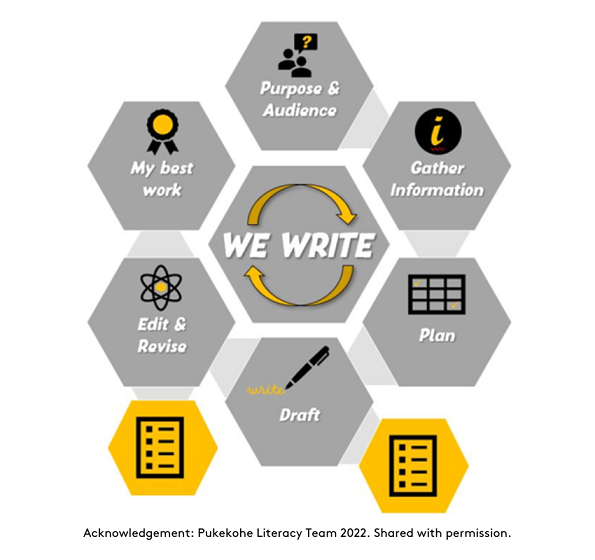It’s a mind shift. A cross-curricular approach to NCEA literacy
By Julie Luxton on September 4, 2023 in Curriculum
This blog describes how one secondary school is enacting the mantra that ‘every teacher is a teacher of literacy’.
Over the past 20 months I have been working with secondary schools in the BOP and Auckland areas to support preparation for NCEA Literacy changes. In an initial school self-review conversation, I was somewhat surprised to hear a senior leader say that sharing responsibility for literacy in and across learning areas, rather than having it sit within English, would require a ‘mind-shift’ in their school. I had assumed that disciplinary literacy was a well-established concept in secondary Aotearoa NZ schools. After all, the Secondary Literacy Project back in the day was a cross-curricular literacy initiative. It would appear that time has passed and momentum has been lost.
In a previous blog I posed a number of questions which schools should be asking themselves as they prepare – with urgency – for the NCEA Literacy co-requisite requirements. One asks how to ensure a cross-curricular approach. This blog describes how one secondary school is enacting the mantra that ‘every teacher is a teacher of literacy’.
‘It takes a village’ – one school’s journey
The journey begins…
Pukekohe High School is a LNSiS school (see footnote). I have been working with the school on this project since late 2021 when I engaged with the senior leadership team in self-review using MOE ‘key conditions for success’ rubrics. Literacy was established as a priority. It was central to the school’s Annual Plan, and became a focus for professional learning, professional growth cycles and individual teacher goal-setting. From the outset, teachers sharing the responsibility for literacy across all learning areas was a key element in the strategy, as shown in the visual below:

Building and supporting the literacy team
A cross-curricular literacy team representing a range of learning areas, including science, social sciences, English, English language (ESOL), art and PE, was appointed. There were also two DPs with professional learning and curriculum responsibilities on the team. The Literacy Co-ordinator was the Assistant HOD English, with qualifications in accounting and business studies, not to mention passion and facilitation talent for the task ahead. In short, the team represented an eclectic disciplinary mix. As the Literacy Co-ordinator would later say, ‘It takes a village’.
The literacy team was given time to build their understanding of the new literacy requirements and collaboratively plan staff professional learning sessions. This time was essential, as it enabled the team to share expertise and fine tune their approach. The MOE resources – Effective Practices that Support NCEA Literacy[1] and available Literacy Pedagogy Guides[2] – helped inform the team’s approach.
Developing a school-wide approach
The first whole staff workshop explained the drivers for changing literacy requirements. This was powerfully illustrated by sharing sample work – a visual text and two poorly composed short paragraphs – which would each give students four NCEA literacy credits under the current system. This helped get staff buy-in as they realised that the standard of literacy in the school would need to be improved, particularly for the new literacy co-requisites.
The literacy team then launched their whole school reading tool – WE READ – to support Big Idea 1 in the NCEA reading matrix[3] (‘Learners make sense of written texts: Learners use a processing system to decode and comprehend text’).

Teachers later participated in an adapted expert jigsaw[4] | co-operative reading[5] task in which they each took on a WE READ role in a group e.g. ‘WHYser’, ‘EXPECTor’, REACHer’, to collaboratively explore a text. In this way an effective reading strategy was modelled for all staff.
Teachers were then given time to collaborate on creating reading activities – an anticipatory reading guide[6], four level guide (Andersen & Glenn, 2021) or an expert jigsaw – for use in an upcoming unit of work. At the next workshop teachers were asked to reflect upon and discuss trialling these reading literacy approaches and strategies in their classrooms – the essential follow-up / accountability component.
In a later whole staff workshop an activity to help teachers understand increasing text complexity at different NZC levels – an identified need – was facilitated. Acknowledging the importance of developing critical reading skills (Big Idea 2), the kaupapa Māori informed Rauru Whakarere Evaluation Framework was introduced as recommended in the NCEA Literacy Pedagogy Guides[2].
A schoolwide approach to writing focused on the writing process, WE WRITE, was also initiated by the literacy team. Staff were asked to identify what stages in the writing process they already had in place and what they needed to focus on in their learning areas.

The journey continues…
Later in 2022 members of the literacy team each worked with different learning areas to ensure that literacy approaches and strategies continued to be implemented in the classroom by all teachers. This support is ongoing as Pukekohe HS works towards sustaining and embedding literacy across the curriculum.
Central to the success of the Pukekohe HS literacy initiative have been some key actions:
Alignment from the Annual Plan through to the classroom
Expectation that teachers would share responsibility for literacy across all learning areas
Establishment of a powerful cross-curricular literacy team
External support from a literacy specialist
Development of easy-to-use resources
Opportunities for teachers to try out a variety of literacy strategies for different contexts
School-wide approaches combined with discipline-specific support
Follow up and accountability
Ongoing support for middle leaders and teachers
In conclusion
There is much we can learn from the Pukekohe HS journey, although every LNSiS school is approaching NCEA Literacy preparation in different ways appropriate to their school contexts. There are many more stories yet to be told.
If every teacher works towards building their understanding and making literacy visible in their learning areas, through trialling just a few new approaches or strategies, there is potential for exponential improvement in NCEA literacy outcomes for learners.
With special thanks to Renée Neville for her input. Renée was one of the DPs on the Pukekohe HS Literacy Team and now works for Evaluation Associates | Te Huinga Kākākura Mātauranga.
Thanks also to the Pukekohe HS SLT and Literacy Team for permission to share their story thus far.
Footnote: This work was part of a regional MOE Literacy and Numeracy Support in Schools (LNSiS) initiative.
Pukekohe High School has granted permission for these downloadable PDFs below. Acknowledgment: Pukekohe Literacy Team 2022.
The literacy resources referred to in the blog
References:
1. NCEA Education: Literacy
2. NCEA Education: The Literacy Pedagogy Guides (LPGs)
3. NCEA Education: Literacy Learning Matrix
4. THE JIGSAW CLASSROOM: https://www.jigsaw.org/#overview
5. Ministry of Education: Cooperative reading/Reciprocal teaching
6. Ministry of Education: Anticipatory reading guides
8. Glenn, J. & Andersen, I. (2021). Secondary literacy: a handbook for teachers, Thames NZ: SimplyLit Ltd.
Keen to find out more? Contact
Other articles you might like
I, for one, am heartened by imminent changes to the NCEA literacy assessment requirements. I’ve always been uneasy about the current expansive pathway, with hundreds of tagged achievement standards from a wide range of subjects, most of which assess content knowledge, with no literacy-specific criteria.
In the last couple of years I have been privileged to work with schools on Kohiko Mai.
Vocabulary knowledge and enrichment in Aotearoa NZ secondary classrooms
